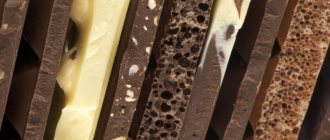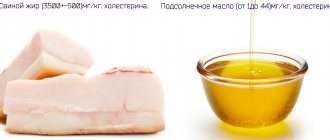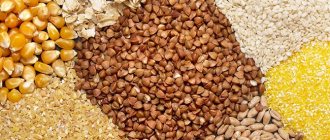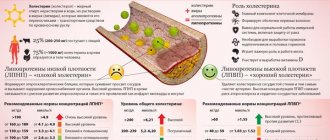Cheese is a hearty food with rich nutritional value, some varieties of which contain more nutrients than some types of meat. However, most of them contain lipids of animal origin, which is dangerous for patients with hypercholesterolemia and increases the risk of developing atherosclerosis.
Cholesterol is indeed present in cheese, and in fairly high concentrations. There is no need to exclude the product from the diet; the main thing is to adhere to the principle of moderation, and also choose varieties with a minimum level of cholesterol compounds.
The nutritional value
Many people love cheese for its delicate taste and piquant smell; not a single feast is complete without it; it is an important component of many dishes. The rich composition makes the product especially valuable for children, the elderly, patients with tuberculosis, weakened after serious illnesses, pregnant and lactating women.
The physical and chemical composition of cheese varies depending on the characteristics of the raw materials, production technology, and recipe. All varieties contain to a greater or lesser extent:
- essential amino acids - lysine, isoleucine, methionine, tryptophan, valine, phenylalline, leucine;
- unsaturated fatty acids, namely linoleic acid, which is especially important for the body;
- vitamins PP, E, D, C, A, B2, B12;
- minerals - calcium, phosphorus, potassium, magnesium, sodium, copper and iron.
The composition of the cheese is as close as possible to the composition of milk, only with a significantly higher concentration of biologically active components.
Composition of cheese, its benefits and harm to the human body
Cheese varieties differ in composition and content of both beneficial and harmful components. But they are all united by a high level of fat content (up to 60% of the total weight), a large amount of protein (up to 30%), minimal content, and sometimes the complete absence of carbohydrates.
Cheeses are rich in:
- vitamins A, C, C, E;
- potassium;
- phosphorus and calcium;
- manganese and sodium;
- zinc, copper and iron;
- amino acids - lysine, methionine, tryptophan, valine, phenylalanine and leucine.
Thus, the benefit of cheese lies in its medicinal and dietary value, which is determined by the content of proteins, vitamins, amino acids and minerals. All this is necessary for the body because:
Allows you to generate energy to support life processes.- Improves the condition of bone tissue.
- Supports vision.
- Increases the growth activity of hair and nails, while strengthening their structure.
- Normalizes digestion processes.
- Promotes healthy hormone synthesis.
- Strengthens the nervous system and immunity.
Unfortunately, in some cases, consuming cheese is harmful . This happens when:
- people suffering from vascular problems and excess cholesterol prefer fatty products without limiting themselves in quantity;
- Cheese lovers with gastritis and stomach ulcers continue to consume it frequently.
To enjoy a treat without worrying about the consequences, it is important to listen to the opinion of your doctor and follow his recommendations.
Beneficial features
To produce high-quality cheese, milk (cow, goat, sheep), a starter of lactic acid bacteria or natural rennet is used - a substance that helps curdle milk and subsequently transform its consistency. Based on the method of precipitation of casein, cheese is classified as rennet or fermented milk.
The value of cheese is determined by its rich composition:
- calcium, together with phosphorus, strengthens bone tissue and regulates mineral metabolism in the body;
- potassium is responsible for heart health and normalizes metabolic processes;
- magnesium increases immune defense, minimizes the risk of developing diabetes, stroke, myocardial infarction;
- sodium regulates neuromuscular activity, promotes the movement of sugar;
- linoleic acid stimulates weight loss, reduces the content of harmful cholesterol fractions;
- vitamins B2 and B12 normalize the function of the nervous system, optimize blood formation, promote hemoglobin synthesis, improve the absorption of amino acids, thereby reducing the saturation of the blood with low-density lipoproteins;
- amino acids activate the breakdown and excretion of lipids, prevent fatty liver hepatosis, and slow down the development of atherosclerosis.
Thanks to proteins and fats, hard cheese is one of the ten highest calorie foods. Less nutritious are soft pickled varieties; they are a more preferable component of a low-calorie diet menu.
Useful tips on nutrition for atherosclerosis
Have you been struggling with CHOLESTEROL for many years without success?
Head of the Institute: “You will be amazed at how easy it is to lower your cholesterol just by taking it every day...
Read more "
Atherosclerosis of arterial vessels is rightfully considered a pathology that determines the health and life expectancy of a modern person. People suffering from heart disease and coronary brain disease know how important diet is for atherosclerosis for the treatment and prevention of complications.
Narrowing of the coronary vessels of the heart leads to serious consequences in the form of angina pectoris, acute heart attack, and contributes to arrhythmias. Brain arteries damaged by atherosclerotic plaques or thromboembolism are unable to deliver oxygen to the tissues. Therefore, acute hypoxia causes a clinical stroke, and chronic changes lead to gradual memory loss and “erasing” of a person as an individual.
Requirements for a balanced diet for atherosclerosis
The role of nutrition in atherosclerosis comes down to the correction of fats, proteins, carbohydrates, microelements and vitamins entering the body, the correct calorie content depending on weight, age category and work performed.
A patient with atherosclerotic changes in blood vessels must:
- eat regularly, avoid long breaks;
- organize 4 meals a day (more frequent if necessary);
- avoid fried, smoked foods, use boiling or stewing;
- exclude from the menu dishes made from fatty foods and easy-to-digest carbohydrates;
- maintain sufficient amounts of protein, vitamins and minerals in food;
- if you are overweight, arrange low-calorie fasting days in consultation with your doctor;
- limit salt and spicy seasonings;
- cook soups with low-fat broths, consume more dairy and vegetable dishes.
When to start a diet?
The first manifestations of atherosclerosis are detected in adolescence and even childhood. It is believed that preclinical diagnostic symptoms can be detected by Doppler ultrasound by changes in the wall of the aorta and carotid arteries. These vessels are at greatest risk of plaque formation.
Changes in coronary blood supply are assessed by ECG. The heart reacts with rhythm disturbances and angina attacks.
Therefore, an early examination (after 40 years) can indicate the onset of the disease and the need for dietary changes.
How many calories should you plan on eating?
The caloric composition of an adult must correspond to his expenses. Remember that obesity brings death closer.
- With a sedentary lifestyle, 2200 kcal is enough.
- An employee with mental work is entitled to at least 2500 kcal.
- It is not harmful for energetic people to consume up to 3000 kcal.
- For physical labor, 4000–5000 kcal, depending on the severity.
Age-related adjustment for calorie reduction:
- up to 45 years - by 100 kcal;
- 45 – 54 – by 200;
- 55 – 64 – by 300.
Nutrition for atherosclerosis requires compliance with the qualitative composition of calories:
- protein should provide 10 - 15% of the total;
- carbohydrates - up to 60%;
- fats - no more than 35%.
What are the benefits of eating certain foods?
The goal of a diet for atherosclerosis is to help the body change its metabolism, reducing fat accumulation from triglycerides and low-density lipoproteins so that they cannot form plaques. Therefore, all dietary products are selected based on the principle of usefulness and harm for this process.
Restrictions on fatty meats are associated not only with excess fat intake, but there is convincing evidence that if there is an excess of animal protein, the body begins to use it to convert it into cholesterol. In this regard, daily consumption of meat is not recommended.
However, switching to complete vegetarianism will not solve all problems, since fat is necessary for the synthesis of enzymes, with it vitamins A, E, D enter the blood. Daily cholesterol intake is limited to 0.3 - 0.4 g per day (compare: the yolk of one chicken eggs contain up to 275 mg of this substance).
Plant foods contain a lot of beta-sitosterol and fiber. They inhibit absorption from the intestine by binding bile acids and removing them in the feces.
Nutritionists suggest replacing the composition of fats in the diet: saturated fatty acids from meat with unsaturated fatty acids from vegetable oils. The mechanism for reducing cholesterol is explained by the great abilities of polyunsaturated acids:
- oxidize the composition of bile;
- capture cholesterol molecules from cell membranes and transport them to the liver for disposal;
- cause an increase in prostacyclin through the consumption of oils rich in linolenic acid.
This substance reduces platelet aggregation and prevents the formation of microthrombi.
Excess triglycerides come from light carbohydrates, sugar, sweets, and flour products. They are especially dangerous when diabetes mellitus and atherosclerosis are combined.
What is not recommended to eat with atherosclerosis
We present standard recommendations from nutritionists. In each case, changes are possible.
The list of prohibited products includes:
- fatty meats (pork, lamb, duck, kidneys, brains, liver);
- any canned meat, sausages, smoked products;
- strong broths from meat, fish, legumes, mushrooms;
- fatty fish and canned fish;
- confectionery products made from butter and puff pastry (bread, rolls, cakes);
- chocolates, ice cream;
- soft varieties of cheese (processed), heavy cream, milk, kefir, sour cream;
- egg yolks;
- hot spices, pickles, snacks (mayonnaise, sauces, mustard, pepper);
- butter, cooking fat;
- semolina and rice porridge;
- strong brewed tea, coffee, cocoa;
- alcoholic drinks and sweet carbonated water;
- Among vegetables, radishes, spinach, radishes, and sorrel are not recommended.
What can you include in your diet?
If the above requirements are met, a person should not feel hungry. Any low-calorie fasting diet should be discussed with your doctor. The diet must include:
- flour products and baked goods made from rye flour with admixtures of bran, grain bread, crackers, savory cookies;
- lean meat (preferably poultry) and fish, boiled or stewed, baked;
- soaked unsalted herring;
- vegetable, dairy, and cereal soups;
- dishes from vegetables (cabbage, carrots, zucchini, beets, pumpkin, eggplant, potatoes), fresh tomatoes, cucumbers, green peas, lettuce;
- dairy products should be purchased low-fat or low-fat (cottage cheese, kefir, sour cream);
- hard cheese, mild - limited;
- soft-boiled eggs are allowed to be consumed no more than once or twice a week, you can prepare protein omelettes;
- cereal products, porridges, casseroles and side dishes (buckwheat, oatmeal, millet, barley);
- all dishes are prepared in vegetable oils (sunflower, corn, olive), butter can be added to the plate in an amount of no more than 1 spoon;
- the tea is not strong, it is better to drink it with milk, lemon, replace coffee with a chicory drink, rosehip decoction, fresh unsweetened vegetable and fruit juices.
Sample table menu No. 10c for 1 day
Breakfast 1: • a piece of boiled meat with vinaigrette, seasoned with vegetable oil; • “Doctorsky” bread; • coffee drink with milk.
Breakfast 2: • seaweed salad; • Rye bread.
Lunch: • cereal soup (barley) with vegetables; • steam cutlets with boiled potatoes; • Rye bread; • rosehip decoction with honey.
Afternoon snack: apple.
Dinner: • baked fish; • Rye bread; • tea with milk, crackers.
In the evening: a glass of low-fat kefir.
The composition of the diet allows you to diversify the menu and prepare delicious dishes. Breaking your diet during the holidays will require more “severe” restrictive measures in the following week. Nutritionists claim that strict adherence to the recommendations allows you to reduce the level of low-density lipoproteins by 10% in a month.
How much cholesterol is in cheese?
The table below contains information about how much cholesterol is in the most popular varieties of cheese - data from the USDA Food Database, as well as studies conducted by scientists in our country.
| Variety | Type | Fat content, % | Cholesterol, mg/100 g |
| Cheddar (Chester) | hard, semi-solid | 48-52 | 95-105 |
| Swiss | semi-solid | 30-60 | 40-95 |
| Gouda | solid | 50 | 114 |
| Parmesan | solid | 35-32 | 68-88 |
| Edam (Edamer) | solid | 30-45 | 35-89 |
| Tilsiter | semi-solid | 30-45 | 37-60 |
| Poshekhonsky | solid | 45 | 80 |
| Emmental | semi-solid | 45 | 94 |
| Russian | solid | 45 | 88 |
| Provolone | semi-solid | 20-30 | 60-69 |
| Processed “Sausage” (smoked) | solid | 45 | 57 |
| Fused "Russian" | soft | 45 | 66 |
| Suluguni | pickle | 25-45 | 55-65 |
| Feta | pickle | 30-60 | <89 |
| Adyghe | soft pickle | 14-40 | 54-79 |
| Brynza | pickle | 30-50 | 50-70 |
| Roquefort | soft, with blue mold | 30-35 | 62-90 |
| Mozzarella | soft | 20-45 | 54-79 |
| Camembert | soft | 30-60 | 38-75 |
| Ricotta | soft | 8-24 | 23-51 |
| Limburgish | soft | 20 | 20 |
| Home | soft | 1-4 | 1-11 |
| Goat | soft | 30 | 79 |
The variability of the above data is explained by production technology, regional characteristics of the recipe, and the type of raw materials. These characteristics can change cholesterol concentrations up or down.
Young cheeses made with low-fat milk, which have a ripening period of about a month, contain low levels of cholesterol. The more mature the cheese, the more substance it contains. Varieties that differ in aging from one month to several years are ahead of meat products in terms of cholesterol content.
What kind of cheese can you eat?
Many fans of this product are interested in the question of what kind of cheese can be eaten with high cholesterol. The answer is: the least amount of animal fat is found in soft and pickled cheeses. This:
- Adyghe cheese;
- feta;
- Mozzarella;
- ricotta;
- Suluguni;
- mascarpone;
- Homemade cheese.
The most useful of them is Adyghe cheese. It is prepared in brine, is not subjected to long-term aging and ripening, and consists of sheep and cow milk. This product is unique in its composition of amino acids and proteins, which in 100 g make up 30% of the daily requirement, polyunsaturated fatty acids (88% of the daily requirement). These acids represent “good” cholesterol, which cleanses blood vessels of excess “bad” cholesterol.
Sheep and goat cheese are also considered low-fat.
As you can see, cheese with high cholesterol is not taboo. If you consume soft, low-fat varieties in moderate doses (120 g twice a week), there will be enough beneficial elements in them for the smooth functioning of systems and organs, and cholesterol levels will not increase.
Pickled cheese
Allowed and prohibited types of cheese
Patients with hypercholesterolemia are not recommended to choose long-ripening fatty cheeses. Despite the undoubted benefits for the body, they help increase the level of harmful cholesterol fractions.
Cheeses with minimal cholesterol content
Today the world knows more than 1000 types of cheese. Depending on the duration of ripening and storage characteristics, four varieties are distinguished: curd (soft), brine, semi-hard, hard. The first two groups are distinguished by relatively low fat content, due to which they are allowed for use in cases of hypercholesterolemia. The following varieties are considered optimal in terms of the ratio of valuable nutrients and cholesterol:
- Adygei is a white friable cheese. Made from cow's milk. Differs in short-term maturation. It is characterized by a delicate unsalted taste, a slightly sour taste, which harmoniously combines with the smell of pasteurized milk. It has pronounced dietary properties, rich in essential amino acids and polyunsaturated fatty acids. It contains cholesterol, but relatively little - from 54 to 79 mg/100 g, depending on the percentage of fat content. Thanks to the balanced composition of antioxidants and amino acids, it promotes the elimination of low-density lipoproteins, thereby stabilizing the atherogenicity coefficient.
- Mozzarella is a soft pickled cheese with a delicate, slightly fresh taste. Made from cow's milk in the form of white balls. Belongs to the category of young cheeses, ripening for 3-4 days. Original Mozzarella can be stored for no more than 10 days. Due to its low calorie content, it belongs to the category of dietary products. Contains a complex of amino acids, antioxidants, vitamins.
- Fresh ricotta (Ricotta Fresca) is a white curd cheese with a delicate, slightly sweet taste. It is a secondary product, as it is made from cow's or sheep's milk whey remaining after fermentation of other types of cheese. Due to this, it has a fairly low fat content - 8-24%. It is a good alternative to butter.
Brynza is a white pickled cheese with a pronounced salty taste. The original recipe involves mixing milk from cows, sheep and buffalos. The optimal ripening period ranges from 40 to 45 days. A dried crust indicates that the product is not fresh. The same is evidenced by an overly rich salty taste. Cheese cheese is useful for hypocalcemia; it quickly restores the balance of intestinal microflora during dysbacteriosis.
The presence of cholesterol is not a contraindication to eating cheese. The main thing is to choose soft varieties with a minimum mass fraction of fat. For patients with atherosclerosis, nutritionists recommend consuming no more than 20-30 g of cheese per day.
Cheese without cholesterol
Tofu is a soy curd cheese with a soft, hard or semi-hard consistency with a neutral taste. It contains no cholesterol, which makes the product an ideal component of the diet of patients with hypercholesterolemia. The product is especially popular among vegetarians.
Produced by combining soy milk with a milk-clotting coagulant. The production technology is practically no different from the production of traditional animal varieties. Tofu contains up to 11% plant proteins, making it a good substitute for meat, eggs, and milk.
Prohibited types of cheese
People whose medical history contains a diagnosis of atherosclerosis are recommended to reduce their intake of cholesterol from food.
If you have high cholesterol, you should exclude from your diet:
- Processed, smoked sausage cheeses. In an attempt to reduce fat content, manufacturers heat-treat the cheese. The result is a tasty soft mass with significantly lower cholesterol levels. Under the influence of high temperatures, some lipids actually break down, but most of the beneficial nutrients leave with them. The body will not derive any benefit from such a product.
- Hard cheeses. Domestic hard varieties are leaders in cholesterol concentration. Some sources indicate critically high levels in Dutch, Russian and Kostroma cheese, namely 510, 1130 and 1550 mg per 100 g of product, respectively. Patients with atherosclerosis are strictly prohibited from consuming these varieties.
- Fake cheeses. High levels of trans isomers indicate that artificially hydrogenated fats like margarine were used during production. Such products are not only useless, they are dangerous. Consumption of trans fats increases the concentration of cholesterol and increases the likelihood of developing cardiovascular diseases.
Lipid concentrations in cheese products
Cheese can increase cholesterol levels because it contains milk. The amount of lipids in the product in question may vary. This depends on the fat content of the milk used in preparation.
Therefore, people with high cholesterol need to limit their cheese consumption and choose only those varieties that have a minimum concentration of harmful fats.
To get rid of excess fat content, manufacturers began to melt cheeses. During this procedure, the vast majority of cholesterol disappears. However, many useful substances and vitamins are also lost. But the taste is preserved and there is no threat to human health.
How to choose
Not all cheeses on store shelves are healthy. Some include the “baggage” of vegetable fats, preservatives, dyes, and pathogenic microorganisms. When choosing a quality product, three points should be considered:
- Compound. Natural milk, salt and milk-clotting component (bacterial or animal) are the only correct components of natural cheese. The presence of vegetable fats automatically defines it as a “cheese product”. Quality cheese does not contain antibiotics, preservatives, dyes – E160 a, E160b, E102, E110, E251.
- Appearance. Stale cheese can be identified by eye. Dried edges, black inclusions, mold, “plastic” crust, uneven color, heterogeneous structure indicate its staleness.
- Package. It is recommended to buy cheeses that were originally packaged by the manufacturer. The product, cut into pieces and wrapped in plastic, is not airtight, so it remains fresh for a short time. In addition, there is no information about the composition. The maximum that a buyer can find out is the name, weight, and price of the block. Lying on the counter for a long time provokes the proliferation of pathogenic microorganisms under the plastic film.
The cheese product is positioned as a budget replacement for natural cheese. Instead of milk fat, the recipe involves the use of vegetable oil, most often palm oil. Naturally, its nutritional value cannot be compared with the original. But at the same time, a high-quality cheese product contains significantly less cholesterol, so it is recommended for consumption by patients with cardiovascular diseases.
Additional advice for patients
You need to eat 4-5 times a day, but in small portions and you need to drink 1.5-2 liters of water per day
To maintain normal cholesterol levels, it is not enough to limit yourself to just eating cheese. It is important to exclude from your diet all foods containing large amounts of unhealthy fats.
A gentle diet is developed by the attending doctor. It should include not only avoiding junk food, but also preventing weight gain. If your body weight is normal, your cholesterol levels will fluctuate less.
Therefore, it is important to adhere to the following recommendations when following a diet:
- Eat small meals, that is, 4-5 times a day, but in small portions.
- Do not violate the diet prescribed by your doctor.
- Do not drink alcohol.
- Eliminate from the diet everything fatty, fried, as well as foods containing many carcinogens and other harmful substances.
- Maintain drinking regime. You need to drink 1.5-2 liters of water per day.
Diet alone will not help manage cholesterol. Experts also advise engaging in moderate physical activity to prevent weight gain. You can’t strain yourself too much; it’s enough to take walks and do exercises every day.
These recommendations will help lower cholesterol, but only temporarily. In any case, the patient must take special medications as prescribed by the attending physician.
You can eat cheese if you have high cholesterol. You just need to give preference to varieties with a low degree of fat content. However, it is not recommended to eat the product daily. It is acceptable to use once every three days.
Source: holesterin.guru
Is it possible to have Adyghe cheese while losing weight?
Nutritionists are only in favor of including the product in the diet when losing weight. It acts as a natural dietary supplement and promotes a healthy weight loss process by losing visceral fat and replacing harmful tissue with muscles.
Interestingly, the “cheese” diet is also used in cases of lack of body weight. People with unhealthy thinness often have impaired vitamin, mineral and protein metabolism. Fermented foods successfully cope with such problems. You just have to increase the calorie content of your diet with a small amount of butter or vegetable oil.
The Adyghe variety can be consumed in its “pure” form or added to salads, soups, julienne, cold and hot appetizers. To preserve nutritional properties, it is better to refrain from preparing hot dishes with Adyghe cheese.
Why is high cholesterol dangerous?
Cholesterol is an important substance for the human body; its chemical structure is a fatty alcohol. It is a building material for the cytoplasmic membrane of all cells and a component of hormones and vitamins
Therefore, most of it is produced by the liver and used by the body as needed.
Cholesterol from food is a kind of reserve and is also used for daily needs. If you exceed the recommended daily intake of this substance from day to day, excess cholesterol will circulate as part of lipoproteins - fat + protein complexes. In large quantities, these complexes (in particular, low density - saturated with fatty alcohol and poor in protein) are the worst enemies of the health of the heart and blood vessels.
Deposited on the walls of the arteries and strengthened by connective tissue, they form dense atherosclerotic plaques, which can completely clog the lumen of the vessel. In this case, the blood circulation of organs and tissues is disrupted and necrosis occurs - irreparable death. The heart and brain “feel” the lack of oxygen and nutrients most quickly, so the most common complications of atherosclerosis are:
- myocardial infarction;
- acute coronary death;
- stroke.
It is worth noting that the risk of developing atherosclerosis under the age of 50 is higher in men than in women. This is due not only to the fact that men are more susceptible to bad habits and stress, which are predisposing factors in the development of the disease, but also to the protective properties of female sex hormones. Estrogens “protect” blood vessels and do not allow cholesterol to rise significantly above normal. Morbidity rates become equal in older patients as the protective effect of female sex hormones ends.
The optimal cholesterol level for healthy people and patients with atherosclerosis is 5.0 mmol/l and below. This is the indicator that you should strive for in order to avoid the deposition of atherosclerotic plaques. If a patient is diagnosed with atherosclerosis and cholesterol values are significantly higher than optimal, in addition to a diet that limits some foods and includes others in the diet, the doctor may prescribe lipid-lowering drugs to correct fat metabolism.
Normal values established for each age category of patients range from 3.5-5.5 mmol/l. If a person has a tendency to increase cholesterol concentration during annual examinations, this is a reason to take the first measures and exclude foods that increase it from the daily diet. This will give results and serve as an effective prevention of atherosclerosis.
Cholesterol above 7.8 mmol/l indicates a critical increase in this value. It is safe to say that such a patient already has atherosclerosis, and his life is in danger: fatal complications of the disease can develop at any time.
Why is it important to diet
Cholesterol is an organic compound consisting of a fatty alcohol. The substance is mostly produced by the liver system of the body, and comes from the outside along with food in relatively small proportions (only 20–25%). In itself, this compound cannot be harmful or beneficial; it is intended for the synthesis of protein metabolism and the formation of cell structure.
But as the amount of cholesterol in the body increases, it begins to be deposited on the vascular walls, eventually leading to the growth of plaques that clog capillaries and interfere with proper blood flow. After 50 years, this state of affairs becomes dangerous for a person: clogged vessels cannot fully supply internal organs and the brain with blood, which is why the risk of heart attack and stroke increases in old age.
And if the body can fight a lack of cholesterol on its own, then an excess of the substance requires a change in diet and habitual (usually not very correct) lifestyle
Why is proper and healthy nutrition so important for high cholesterol:
promotes the removal of decay products, toxins and toxins accumulated in the intestinal tissues from the body; helps to lose weight, which is important for high cholesterol - almost all obese people have problems with blood vessels, high blood pressure and suffer from cardiovascular pathologies; helps prevent the development of atherosclerosis in women over fifty years of age - during menopause, estrogen production decreases, which is why “harmful” cholesterol begins to actively accumulate on the vascular walls; indirectly participates in the treatment of concomitant diseases - the gastrointestinal tract (gastrointestinal tract), diabetes, hypertension.
To begin the fight against cholesterol, it is important not only to understand the principles of proper nutrition, but also to give up bad habits. Vessels, already narrowed due to the deposition of cholesterol plaques, experience additional spasm when tobacco tar and ethyl alcohol enter the blood
Only an integrated approach, including diet, quitting smoking and alcohol, providing the body with stable physical activity and frequent exposure to fresh air, can qualitatively reduce blood cholesterol levels. If the doctor has prescribed medications at the same time, the recommendations must be strictly followed.
Red caviar: does it contain cholesterol and who should avoid it?
Have you been struggling with CHOLESTEROL for many years without success?
Head of the Institute: “You will be amazed at how easy it is to lower your cholesterol just by taking it every day.
With red caviar, the concepts of wealth, success, and well-being involuntarily come to mind. The delicious taste and unique properties of caviar symbolize healthy nutrition in a prosperous, prosperous family. It is obtained from salmon fish - pink salmon, chum salmon, coho salmon and sockeye salmon. Caviar is one of the rare products that contains a complex of substances necessary for the body. After all, one grain gives rise to a new life.
- Composition of caviar
- Caviar and cholesterol
- What is bad and good cholesterol
- What is cholesterol for?
- Foods to lower cholesterol
No one doubts the valuable qualities of this product. Meanwhile, there is an opinion that cholesterol in red caviar is harmful for atherosclerosis. Let's figure out what the reality is on this issue. Let's learn how to use caviar correctly so that it can be beneficial. Along the way, we will explain what blood cholesterol is. Does the body need it or is it harmful?
Our readers successfully use Aterol to lower cholesterol. Seeing how popular this product is, we decided to bring it to your attention. Read more here...
Composition of caviar
The beneficial qualities of red caviar are assessed by its composition:
- Protein 30%.
- Fats 15–18%.
- Carbohydrates 4%.
- Folic acid, necessary for improving skin, prevents anemia.
- Iodine, necessary for the functioning of the thyroid gland.
- Lecithin is the main source of energy for nerve cells.
- Minerals: iron, zinc, potassium, potassium, phosphorus, magnesium.
- Vitamins A, D, E and B maintain the beauty of skin, hair and nails, support our vision and ensure the absorption of calcium needed by bones and teeth.
The protein in its composition is easily digestible compared to what is found in meat or milk.
Polyunsaturated fatty acids Omega-3 and Omega-6, being antioxidants, maintain youth, fight the aging of the body and counteract the development of cancer. These acids, by strengthening blood vessels, reduce the likelihood of cardiovascular diseases.
Iron increases hemoglobin levels. Potassium improves the contractility of the heart muscle. Phosphorus improves brain activity. Zinc improves immunity. Calcium and magnesium are elements of the functionality of the musculoskeletal system.
Caviar and cholesterol
Like all animal products, caviar also contains cholesterol. 100 grams of product contains 300 mg of cholesterol. But there is an important feature - the cholesterol in caviar is neutralized by the lecithin, Omega-3, Omega-6 it contains. Thus, caviar contains good cholesterol (HDL).
Researchers at the Spanish University of Almeria have proven that red caviar lowers blood cholesterol. Based on biochemical tests, scientists have confirmed that red caviar is able to remove blood cholesterol and delay the aging of the body thanks to Omega-3 and Omega-6. At the same time, red caviar is included in the list of cholesterol-containing foods in the British diet.
Patients with high cholesterol and coronary heart disease are not recommended to take caviar.
This does not mean that healthy people should refrain from consuming such a valuable product. To prevent caviar from increasing blood cholesterol, you need to know how to use it correctly.
Foods with high cholesterol levels
The disease of excess lovers
Atherosclerosis is one of the most common vascular diseases. It can be caused not only by excess nutrition, but also by bad habits.
1. Most cholesterol is found in fatty meats.
- beef and pork. Try not to buy fatty brisket, neck, tenderloin, ribs and other cuts of carcass that contain a large amount of fat.
Remember that a large amount of hidden fat
It is even found in pork fillet. A good alternative to such a product would be lean chicken and turkey.
2. Avoid such by-products
, like the liver, lung and brains. One serving (about 200 g) can contain most of the daily value of cholesterol.
3. Increased Saturated Fat and Cholesterol in Processed Meats
: ham, sausages, sausages, canned meats and smoked meats.
Even boiled sausage without lard contains hidden fats. In addition, these foods contain too much salt.
Fatty poultry also contains a lot of cholesterol.
- goose or duck. Avoid frying these foods in fat, trim off excess fat, and choose dark meat from the breast or legs of the bird after removing the skin.
5. Eggs are often accused of containing excess cholesterol. However, compared to fatty meat or smoked meats, eggs contain so much of this substance.
However, experts recommend limiting your consumption to one egg per day.
or prepare meals using only proteins. You shouldn’t completely give up eating eggs: they contain many useful substances.
6. Major suppliers of cholesterol are butter, cheeses, sour cream and full-fat yoghurts.
, which usually also contain large amounts of added sugar.
Nutritionists recommend consuming skim or low-fat milk and other dairy products containing no more than two and a half percent fat.
7. The lion's share of cholesterol enters the human body through semi-finished products, industrial baked goods, and desserts.
and fast food. These foods contain trans fats as well as high amounts of saturated fat.











